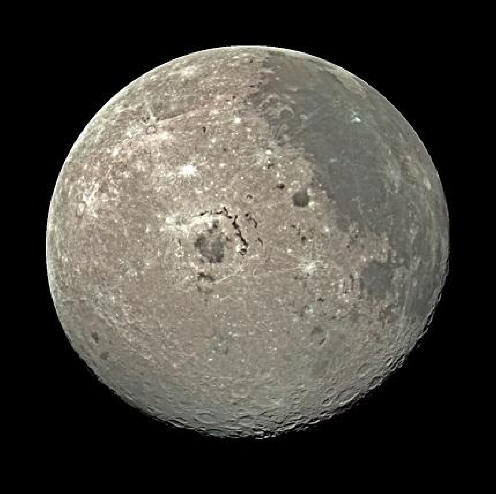|
|
Multi-Ringed Basins
Dec
12, 2008
Lunar
formations resemble those found on
other planets and moons. Could they
be the result of similar electrical
events?Mare
Orientale is located on the western
rim of the Moon, making it difficult
to see from Earth. It has a nearly
complete
concentric ring structure with a
surrounding basin of mare material.
The mare is bounded inwardly by
steep scarp and topped by sharp
massifs. Maunder crater lies nearby
in the northern region, while to the
southeast is Kopff. Montes Rooks
lines its eastern edge.
As time has progressed, and more
evidence for electrical scarring on
the various bodies in the Solar
System has become known, it is now
possible to categorize particular
features that are found "out there,"
as well as here on our planet. One
of those categories could be called
"multi-ringed basins," because many
different locations on other worlds
besides our own share this common
feature.
All of them have
flat inner plains with vertical
cliffs encircling the interior, such
as
Renoir Basin on Mercury. Some of
those cliffs are several kilometers
high. A
secondary plain that will
sometimes have a deep outer
perimeter, like a v-shaped canyon,
is another common feature.
Surrounding that secondary plain
will be
another ring of cliffs, often
higher than the inner ring, with a
more gradual drop-off extending
outward from the central structure.
In some of the larger basins that
pattern is repeated several more
times, with shorter cliffs and
broader plains, until they finally
merge into the bedrock.
They are found (in no particular
order) on
Ganymede,
Tethys, The Moon, Mercury,
Callisto, Miranda, Earth, Venus,
Mars, and most likely other
locations soon to be discovered.
When future space probes are sent to
explore the moons and planets, it is
probable that more of these
multi-ringed basins will be found.
What created the basins? Was it the
impact theory as favored by
consensus opinion? Did gigantic
mountains of rock strike all the
bodies listed above? Did a
10-kilometer-wide meteor impact
Earth and excavate the multi-ringed
Chicxulub crater that supposedly
killed-off the dinosaurs?
Laboratory experiments with electric
currents in plasma show that the
currents can appear in three modes:
dark, glow and arc, depending on the
voltage and charge density. The arc
mode, which has a very high charge
density, is used for precision
machining in metal.
The degree of current filamentation
depends on the density of the medium
through which the current passes.
With similar current flows, one
passing through a vacuum (or a thin
atmosphere) produces a columnar
channel that spins around its axis.
In the glow mode, this channel looks
like a tornado of fire. The same
current, if it travels through a
thick atmosphere, branches into
filaments. These filaments form
concentric circles around the
primary axis.
When electricity passes through a
solid body it erodes material from
the surface where the arc touches
down. The pits or craters left by
electric arcs are usually circular
because the electric forces
constrain the arc to strike at a
right angle to the surface. An
electric arc is composed of two (or
more) filaments rotating around a
common center, so the surface is
excavated by a plasma "drill bit,"
leaving steep sides and a “pinched
up” rim of debris.
If the filaments are sufficiently
separated, the bottom of the crater,
as the material is removed, will be
electrically heated, possibly
burned, and then melted flat. This
explains why so many of the inner
regions of multi-ringed formations
are so often dark. The abundance of
small craters that appear
on the rims of the larger rings
testifies to the probability of
electric arc discharges. As the arc
travels, it punches out a
chain of craters. If the craters
overlap, the result is a steep-sided
trench with scalloped edges. The arc
can cut a trench and then jump some
distance away before cutting another
one.
It is possible that the origin of
the multi-ringed basins is not due
to asteroid or comets impacts
billions of years ago, but to the
action of interplanetary electric
arcs, burning hot and explosively
violent.
By Stephen Smith
|
|
|
|
|
|
SPECIAL NOTE - **New Volumes Available:
We are pleased to announce a new
e-book series
THE UNIVERSE ELECTRIC. Available now, the first volume
of this series, titled Big Bang, summarizes the failure of modern cosmology
and offers a new electrical perspective on the cosmos. At
over 200 pages, and
designed for broadest public appeal, it combines spectacular
full-color graphics with lean and readily understandable
text.
**Then second and third volumes in the series are now available,
respectively titled Sun and Comet, they offer
the reader easy to understand explanations of how and why these bodies
exist within an Electric Universe.
High school and college students--and teachers in
numerous fields--will love these books. So will a large
audience of general readers.
Visitors to the Thunderbolts.info site have often
wondered whether they could fully appreciate the Electric
Universe without further formal education. The answer is
given by these exquisitely designed books. Readers from
virtually all backgrounds and education levels will find them
easy to comprehend, from start to finish.
For the Thunderbolts Project, this series is a milestone.
Please see for yourself by checking out the new
Thunderbolts Project website, our leading edge in
reaching new markets globally.
Please visit our
Forum
|
|
|
|
|
|
|
|







